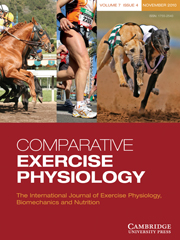Crossref Citations
This article has been cited by the following publications. This list is generated based on data provided by
Crossref.
FERLAZZO, A.
MEDICA, P.
CRAVANA, C.
and
FAZIO, E.
2010.
Effects of fence height on total and free iodothyronine changes in horses after experimental show jumping sessions.
Equine Veterinary Journal,
Vol. 42,
Issue. s38,
p.
110.
CRAVANA, C.
MEDICA, P.
PRESTOPINO, M.
FAZIO, E.
and
FERLAZZO, A.
2010.
Effects of competitive and noncompetitive showjumping on total and free iodothyronines, β‐endorphin, ACTH and cortisol levels of horses.
Equine Veterinary Journal,
Vol. 42,
Issue. s38,
p.
179.
MEDICA, P.
GIACOPPO, E.
FAZIO, E.
AVENI, F.
PELLIZZOTTO, R.
and
FERLAZZO, A.
2010.
Cortisol and haematochemical variables of horses during a two day trekking event: effects of preliminary transport.
Equine Veterinary Journal,
Vol. 42,
Issue. s38,
p.
167.
Ferlazzo, Adriana
Medica, Pietro
Cravana, Cristina
and
Fazio, Esterina
2012.
Circulating β-Endorphin, Adrenocorticotropin, and Cortisol Concentrations of Horses Before and After Competitive Show Jumping with Different Fence Heights.
Journal of Equine Veterinary Science,
Vol. 32,
Issue. 11,
p.
740.
Fazio, Esterina
Medica, Pietro
Cravana, Cristina
and
Ferlazzo, Adriana
2013.
Hypothalamic-pituitary-adrenal axis responses of horses to therapeutic riding program: Effects of different riders.
Physiology & Behavior,
Vol. 118,
Issue. ,
p.
138.
Fazio, Esterina
Medica, Pietro
Cravana, Cristina
Molinari, Piergiorgio
and
Ferlazzo, Adriana
2014.
Effect of Experience on Adrenocortical and Thyroid Responses of Arabian Horses to Gymkhana Games.
Journal of Equine Veterinary Science,
Vol. 34,
Issue. 6,
p.
799.
Bruschetta, Giuseppe
Di Pietro, Patrizia
Fazio, Esterina
and
Ferlazzo, Alida M.
2014.
Plasma serotonin, tryptophan, hematological, and functional responses to horse trekking.
Journal of Veterinary Behavior,
Vol. 9,
Issue. 5,
p.
248.
Huntingford, Janice L.
Levine, Corri B.
Mustacich, Debbie J.
Corrigan, Devin
Downey, Robert L.
and
Wakshlag, Joseph J.
2014.
The Effects of Low Intensity Endurance Activity on Various Physiological Parameters and Exercise Induced Oxidative Stress in Dogs.
Open Journal of Veterinary Medicine,
Vol. 04,
Issue. 07,
p.
134.
Ferlazzo, Adriana
Fazio, Esterina
Cravana, Cristina
and
Medica, Pietro
2014.
Changes of Circulating Total and Free Iodothyronine in Horses After Competitive Show Jumping With Different Fence Height.
Journal of Equine Veterinary Science,
Vol. 34,
Issue. 7,
p.
876.
Lee, Seungwoo
Oh, Dayoung
Kim, Myung-Chul
Kim, Yongbaek
and
Ryu, Doug-Young
2015.
A novel biomarker of exercise-induced stress in horses.
Korean Journal of Veterinary Research,
Vol. 55,
Issue. 4,
p.
247.
Fazio, Esterina
Medica, Pietro
Cravana, Cristina
and
Ferlazzo, Adriana
2016.
Comparative Exploration of the β-endorphin, Adrenocorticotrophic Hormone, and Cortisol Patterns' Response to Simulated and Conventional Transportations of Stallions ( Equus caballus ).
Journal of Equine Veterinary Science,
Vol. 44,
Issue. ,
p.
74.
Kang, Ok-Deuk
and
Lee, Wang-Shik
2016.
Changes in Salivary Cortisol Concentration in Horses during Different Types of Exercise.
Asian-Australasian Journal of Animal Sciences,
Vol. 29,
Issue. 5,
p.
747.
Cravana, Cristina
Medica, P.
Ragonese, G.
and
Fazio, E.
2017.
Influence of training and competitive sessions on peripheral β-endorphin levels in training show jumping horses.
Veterinary World,
Vol. 10,
Issue. 1,
p.
67.
Munk, R.
Jensen, R.B.
Palme, R.
Munksgaard, L.
and
Christensen, J.W.
2017.
An exploratory study of competition scores and salivary cortisol concentrations in Warmblood horses.
Domestic Animal Endocrinology,
Vol. 61,
Issue. ,
p.
108.
Ferlazzo, Adriana
Fazio, Esterina
Cravana, Cristina
and
Medica, Pietro
2018.
The Role of Circulating β-endorphin in Different Stress Models in Equines: A Review.
Journal of Equine Veterinary Science,
Vol. 71,
Issue. ,
p.
98.
Ferlazzo, Adriana
Cravana, Cristina
Fazio, Esterina
and
Medica, Pietro
2018.
Is There an Interplay Between the Hypothalamus-Pituitary-Thyroid and the Hypothalamus-Pituitary-Adrenal Axes During Exercise-Stress Coping in Horses?.
Journal of Equine Veterinary Science,
Vol. 62,
Issue. ,
p.
85.
STRZELEC, Katarzyna
PIETRZAK, Sławomir
PRÓCHNIAK, Tomasz
JANCZAREK, Iwona
CYWIŃSKA, Anna
and
BEREZNOWSKI, Andrzej
2020.
Salivary cortisol levels in horses and their junior riders during show jumping.
TURKISH JOURNAL OF VETERINARY AND ANIMAL SCIENCES,
Vol. 44,
Issue. 2,
p.
391.
Cravana, Cristina
Fazio, Esterina
Ferlazzo, Adriana
and
Medica, Pietro
2021.
Therapeutic Riding Horses: using a hypothalamic-pituitary-adrenal axis measure to assess the physiological stress response to different riders.
Journal of Veterinary Behavior,
Vol. 46,
Issue. ,
p.
18.
Barton, A
Lindenberg, I
Einspanier, A
Merle, R
and
Gehlen, H
2022.
Evaluation of the effect of tongue ties on stress parameters, behaviour and heart-rate variability in racehorses.
Animal Welfare,
Vol. 31,
Issue. 2,
p.
231.
Ireland, J.L.
Lester, A.
and
Banse, H.E.
2024.
Factors affecting measurement of basal adrenocorticotropic hormone in adult domestic equids: A scoping review.
The Veterinary Journal,
Vol. 304,
Issue. ,
p.
106071.


